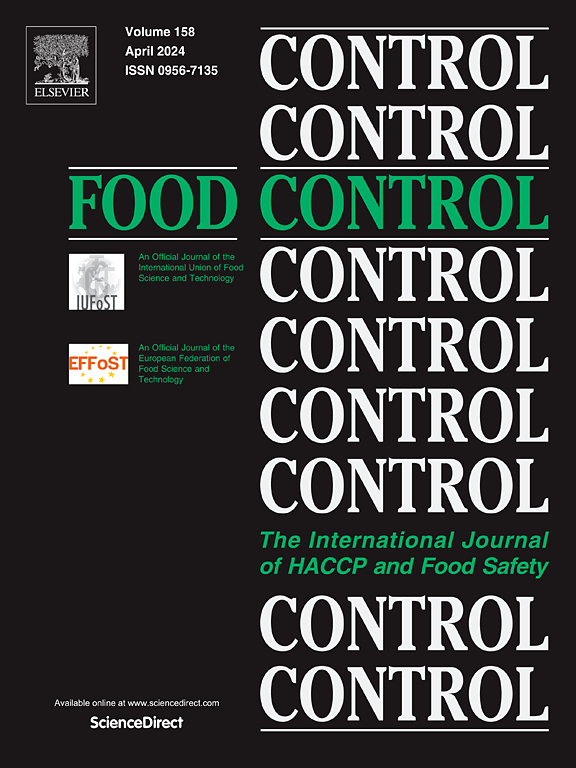一种新型 K57 特异性肺炎克雷伯氏菌噬菌体可为牛奶消毒并抑制生物膜形成
IF 5.6
1区 农林科学
Q1 FOOD SCIENCE & TECHNOLOGY
引用次数: 0
摘要
肺炎克雷伯氏菌(K. pneumoniae),尤其是血清型 K57,是奶牛乳腺炎的主要病原体,造成重大经济损失,并通过污染乳制品对公共健康构成威胁。此外,K57 在感染人类的血清型中毒性很强,可导致化脓性肝脓肿等严重病症。在这项研究中,我们分离并鉴定了一种名为 vB_Kp_Z57 的噬菌体,它的目标是来自人类和牛的 K57 血清型肺炎双球菌分离物。该噬菌体的潜伏期为 4 分钟,每个受感染的细菌细胞可产生约 233 个噬菌体。vB_Kp_Z57 在 4 °C 至 60 °C 的温度范围和 5-11 的 pH 值范围内都很稳定。噬菌体基因组的测序和组装显示,DNA 分子由 40,316 个碱基对组成。使用生物信息学软件对基因组进行注释后发现,噬菌体基因组编码 48 种蛋白质,没有检测到溶菌基因、毒素基因或 tRNA 相关基因。vB_Kp_Z57 被归类为 Przondovirus 属、Autographiviridae 科的成员。抑菌实验结果表明,vB_Kp_Z57具有良好的抑制细菌生长的作用。值得注意的是,vB_Kp_Z57 能显著抑制冷藏温度为 4 °C和室温条件下牛奶中宿主细菌的生长。生物膜抑制实验显示,vB_Kp_Z57噬菌体能显著降低所有噬菌体处理组的OD595值,这表明它有可能成为一种有效的肺炎双球菌生物控制剂。我们的研究结果表明,vB_Kp_Z57 是一种新型、环保的解决方案,有望解决乳制品生产中与肺炎双球菌相关的难题。本文章由计算机程序翻译,如有差异,请以英文原文为准。
A novel K57-specific Klebsiella pneumoniae phage disinfects milk and inhibits biofilm formation
Klebsiella pneumoniae (K. pneumoniae), especially serotype K57, is a major pathogen in dairy bovine mastitis, causing significant economic losses and posing a public health risk through contaminated dairy products. In addition, K57 is highly virulent among serotypes infecting humans, leading to serious conditions such as pyogenic liver abscess. In this study, we isolated and identified a bacteriophage called vB_Kp_Z57 that targets K57 serotype K. pneumoniae isolates from human and bovine sources. The phage has a latent period of 4 min and can produce approximately 233 phages per infected bacterial cell. vB_Kp_Z57 is stable over a temperature range of 4 °C to 60 °C and a pH range of 5–11. Sequencing and assembly of the phage genome revealed DNA molecules consisting of 40,316 base pairs. After genome annotation with bioinformatics software, it was discovered that the phage genome encodes 48 proteins, with no detected lysogeny genes, toxin genes, or tRNA-related genes. vB_Kp_Z57 was classified as a member of genus Przondovirus, family Autographiviridae. The results of bacteriostatic experiments show that vB_Kp_Z57 has a good effect on inhibiting bacterial growth. Notably, vB_Kp_Z57 significantly inhibited the growth of its host bacteria in milk at refrigerated temperatures of 4 °C and room temperature. Biofilm inhibition experiments revealed that phage vB_Kp_Z57 significantly reduced OD595 values in all phage-treated groups, indicating its potential as an effective biocontrol agent against K. pneumoniae. Our findings show the promise of vB_Kp_Z57 as a novel and environmentally friendly solution to address the challenges associated with K. pneumoniae in dairy production.
求助全文
通过发布文献求助,成功后即可免费获取论文全文。
去求助
来源期刊

Food Control
工程技术-食品科技
CiteScore
12.20
自引率
6.70%
发文量
758
审稿时长
33 days
期刊介绍:
Food Control is an international journal that provides essential information for those involved in food safety and process control.
Food Control covers the below areas that relate to food process control or to food safety of human foods:
• Microbial food safety and antimicrobial systems
• Mycotoxins
• Hazard analysis, HACCP and food safety objectives
• Risk assessment, including microbial and chemical hazards
• Quality assurance
• Good manufacturing practices
• Food process systems design and control
• Food Packaging technology and materials in contact with foods
• Rapid methods of analysis and detection, including sensor technology
• Codes of practice, legislation and international harmonization
• Consumer issues
• Education, training and research needs.
The scope of Food Control is comprehensive and includes original research papers, authoritative reviews, short communications, comment articles that report on new developments in food control, and position papers.
 求助内容:
求助内容: 应助结果提醒方式:
应助结果提醒方式:


